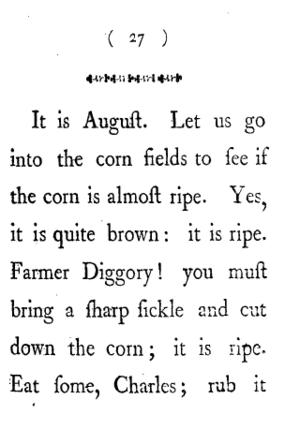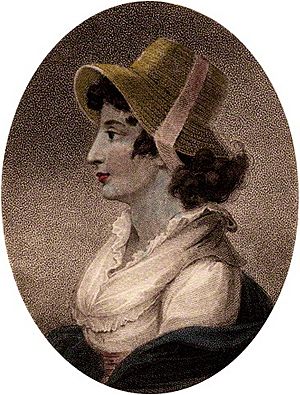Lessons for Children facts for kids
Lessons for Children is a set of four reading books written by the famous 18th-century British writer Anna Laetitia Barbauld. These books, published in 1778 and 1779, changed children's literature in the English-speaking world. For the first time, the books really thought about what young readers needed.
The books were designed to get harder as a child learned more. They used a friendly, conversational style, like a mother and her son talking about nature. Barbauld's books taught children by having them learn through their senses, which means touching, seeing, hearing, smelling, and tasting things.
A main message in Lessons is that everyone is part of a community. The main character, Charles, learns about his connection to nature, animals, other people, and even God.
Lessons had a big effect on children's books in Britain and the United States. Many famous writers like Maria Edgeworth and Sarah Trimmer were inspired by Lessons to write their own children's books. Lessons itself was printed again and again for over a hundred years.
Contents
How the Books Were Made and What They Taught
Publication and Book Design
Lessons shows a mother teaching her son. Many of the stories likely came from Barbauld teaching her own adopted son, Charles. The events in the books match his age as he grew up.
The series was often published as one book. Barbauld insisted that her books be printed with large letters and wide spaces around the text. This made them easy for children to read. She was probably the first to do this, and she certainly made it popular.
These changes also meant the books were too expensive for poor children. So, Barbauld's books helped create a special look for middle-class children's books.
The books were made for readers who were just learning. They started with simple words and then moved to longer words. The first part of Lessons has easy sentences like: "Ink is black, and papa's shoes are black. Paper is white, and Charles's frock is white." The later parts get harder: "February is very cold too, but the days are longer, and there is a yellow crocus coming up, and the mezereon tree is in blossom, and there are some white snow-drops peeking up their little heads."
Barbauld also added parts of stories before telling a full story. For example, she explained the days of the week before Charles took a trip to France. This helped children understand how events happen in order.
Learning Through Experience

Barbauld's Lessons teaches children about all kinds of language. Readers learn to read, but they also learn to understand comparisons and ideas. The fourth book especially helps children think in a poetic way.
Barbauld also created a special style that became very popular in children's books. It was an "informal dialogue between parent and child." This means it was a friendly conversation that focused on talking and listening. Lessons starts with the mother doing most of the talking. But as the books go on, Charles's voice is heard more and more. He becomes more confident in reading and speaking. This style was a new idea compared to how children were usually taught back then, which was often just memorizing things.
Barbauld's Lessons also shows the mother and child doing everyday things and taking walks in nature. Through these activities, the mother teaches Charles about the world around him. He gets to explore it himself. This was also a new idea for teaching. Teachers usually just described things instead of letting children experience them. The mother shows Charles the seasons, different times of day, and minerals by taking him to see them. Charles learns about plants, animals, numbers, chemistry, money, the calendar, geography, weather, farming, and stars. He also asks questions about everything, which makes learning exciting.
Barbauld's teaching ideas were based on the thoughts of John Locke, a famous thinker. He believed that children learn by connecting ideas. Because of these new ideas about how children learn, Barbauld and other women writers created the first books designed for specific age groups.
Main Ideas in the Books

Lessons not only teaches reading, but it also helps children understand how society works. It teaches them good behavior and how to feel about things. One main goal of the series is to show that Charles is better than the animals he meets. This is because he can talk and reason. Lessons for Children, of Three Years Old, part 2 begins:
Do you know why you are better than Puss? Puss can play as well as you; and Puss can drink milk, and lie upon the carpet; and she can run as fast as you, and faster too, a great deal; and she can climb trees better; and she can catch mice, which you cannot do. But can Puss talk? No. Can Puss read? No. Then that is the reason why you are better than Puss—because you can talk and read.
Charles learns to care for other people by first helping animals. Barbauld's Lessons does not focus on just one person alone. Instead, it shows that "every human being needs other human beings to live. Humans are communal entities," meaning we live in communities.
Lessons was probably meant to be read with Barbauld's Hymns in Prose for Children (1781). Both books were written for Charles. They both share the idea that a child should look at nature. By doing so, they will learn about God. However, some modern experts have pointed out that Lessons does not talk much about religion, especially compared to Hymns. They say this means Lessons is more about everyday life.
One important idea in Lessons is how children are guided. Some people see this as a good thing, while others see it as a bad thing. Some experts say that the "new child" of the 18th century was very dependent on adults. This child rarely made big decisions without their parents' approval. They were seen as obedient and well-behaved.
Other experts say that Barbauld shows children being guided only to show them becoming free later in the series. In this view, education for Barbauld is a journey from being guided to being free. This is shown by Charles slowly moving from his mother's lap in the first book to a stool next to her, and then finally being able to move around on his own in the last book.
Images for kids
-
Benjamin Harris's Protestant Tutor, a popular reading book before Barbauld's Lessons. Notice how crowded the page looks compared to Barbauld's books.
See also
 In Spanish: Lessons for Children para niños
In Spanish: Lessons for Children para niños



